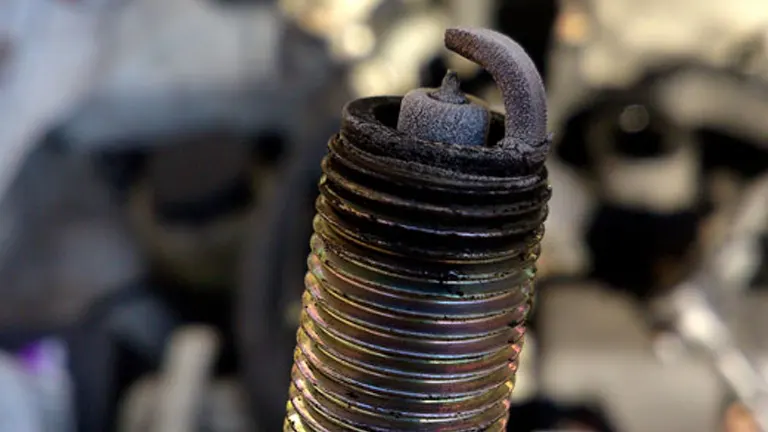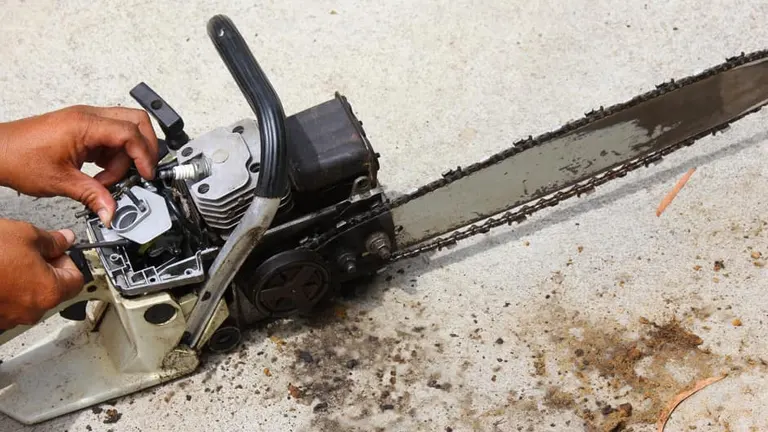How to Mix Oil & Gas for 2 Stroke Engines
- January 31, 2024
- 1 comment
Using the correct fuel mixture is paramount for the efficient and safe operation of 2-stroke engines commonly found in outdoor power equipment like string trimmers, chainsaws, and leaf blowers. This guide will walk you through the process of mixing oil and gas for your 2-stroke engine equipment, specifically focusing on STIHL products, though the principles generally apply across different brands.
Understanding the Importance of Proper Fuel Mixture
Understanding the critical importance of the proper fuel mixture is fundamental to maintaining the efficiency and durability of gasoline-powered equipment. For a majority of STIHL equipment, a precise 50:1 ratio of gasoline to 2-cycle engine oil is recommended.

This specific ratio is meticulously determined, not just to keep the engine running, but to optimize its performance and extend its lifespan. Adhering to this ratio ensures that the engine is well-lubricated during operation, reducing the risk of wear and tear on internal components. It’s this careful balance of fuel and oil that allows the engine to perform at its best, minimizing potential issues and ensuring that your equipment remains reliable and effective over time. Thus, understanding and respecting the recommended fuel mixture ratio is not just about maintaining engine performance; it’s about committing to the longevity and reliability of your valuable equipment.
Steps for Mixing Oil and Gas
When it comes to mixing oil and gas for your 2-stroke engine, precision and care are vital. Following a systematic approach not only ensures the longevity of your equipment but also safeguards its performance. Here are the steps you should adhere to for a proper mix:
- Begin by consulting your equipment’s instruction manual. It’s your primary source for specific instructions regarding the fuel mixture and other critical operational guidelines. This ensures you’re aligning with the manufacturer’s recommendations for optimal performance and safety.
- Choose a certified gasoline container, ideally a No-Spill type, designed to mitigate spillage, evaporation, and permeation. The right container is not just about convenience; it’s about safety and preserving the quality of your fuel mix.
- Fuel quality cannot be compromised. Select a mid-grade unleaded gasoline with a minimum octane rating of 89. Lower octane levels can elevate engine temperatures, potentially leading to piston seizure or even extensive engine damage. Quality fuel ensures clean combustion and safeguards engine internals.
- For STIHL equipment, a 50:1 ratio of gasoline to oil is typical. Start by pouring the oil into your container, followed by the gasoline. Seal and shake the container vigorously to achieve a homogenous mixture. This step is crucial to ensure even lubrication and combustion when the fuel is in use.
- Before you pour the mixture into your equipment, clean the fuel cap area meticulously. This prevents contaminants from entering the fuel system. Open the fuel cap gently to allow any built-up pressure to dissipate safely, minimizing the risk of spills or hazardous fumes.
- Mix fuel in quantities that align with your immediate usage, ideally enough for a few days. Prolonged storage (beyond three months) can degrade fuel quality. If the mixture has been sitting, always give it a good shake before use to ensure the oil and gasoline are well mixed.
Understanding 2-Cycle/2-Stroke Ratio Chart
Mixing fuel for 2-cycle engines is key to performance and longevity. The ideal gas-to-oil ratio varies by engine age—newer ones often use a 40:1 mix, while older models may need a richer 32:1 blend. Always check the manual for the right recipe to keep your machine humming. Here’s a simplified guide to help you determine the right fuel-to-oil ratio for your 2-cycle engine equipment:
| Mixing Ratio (Gas: Oil) | Volume of Gasoline | Volume of 2-Cycle Oil |
|---|---|---|
| 32:1 | 1 US gal (128 Oz) | 4 Oz |
| 40:1 | 1 US gal (128 Oz) | 3.2 Oz |
| 50:1 | 1 US gal (128 Oz) | 2.6 Oz |
| 32:1 | 1 liter | 31.25 ml |
| 40:1 | 1 liter | 25 ml |
| 50:1 | 1 liter | 20 ml |
- Equipment Manufactured Before 2003:
- The recommended mixture is a 32:1 ratio of gasoline to oil. This means for every 32 parts of gasoline, one part of oil is required.
- If you are in California, due to specific state regulations, the ratio adjusts slightly to 40:1. This is to comply with environmental standards and ensure optimal engine performance.
- Equipment Manufactured After 2002:
- Technology advancements have allowed for a leaner mixture. For these newer models, a 40:1 gasoline to oil ratio is recommended. This ensures adequate lubrication while optimizing fuel efficiency and minimizing emissions.
- Unsure of Your Equipment’s Age?
- When in doubt, it’s prudent to use a 40:1 mixture. This ratio is generally safe for most 2-cycle engines and will provide sufficient lubrication without the risk of damaging the engine due to an incorrect fuel mix.
Troubleshooting Tips for Common Problems Related to Improper Fuel Mixtures
1. Fouled Spark Plug

A fouled spark plug is a common issue indicating an overly rich fuel mixture. This condition is identifiable by a spark plug that is coated with an oily or carbon residue. The presence of this residue is a clear sign that the fuel-to-oil ratio is imbalanced, leading to incomplete combustion. To tackle this issue, begin by carefully cleaning the spark plug to remove any deposits. Then, reassess and adjust your fuel-to-oil mixture to ensure it aligns with the recommended ratio. A correctly balanced mixture will not only prevent future fouling but also restore engine efficiency and performance.
2. Engine Flooding

Engine flooding is another frequent complication, often arising from an excessively rich fuel mixture or improper starting techniques. Symptoms of a flooded engine include the inability to start and a pronounced smell of gasoline emanating from the engine. This occurs when excess fuel overwhelms the combustion chamber, effectively drowning the spark necessary for ignition. To rectify this, allow the engine to sit undisturbed for a few minutes, permitting the surplus fuel to evaporate. Subsequently, attempt to start the engine with the throttle in a fully open position. This procedure introduces a higher volume of air into the mixture, counterbalancing the excess fuel and facilitating the ignition process. Addressing engine flooding promptly can prevent further complications and ensure the smooth operation of your 2-stroke engine.
Practical Tips for Mixing
In the meticulous process of mixing oil and gas for 2-stroke engines, a few practical tips can make a significant difference, enhancing efficiency and prolonging the life of your engine. These tips revolve around precision, proper procedure, and preventive measures to ensure your engine operates at its best. Here’s a consolidated guide to achieving the perfect mix:
- Adopt the metric system for more accurate measurements. Remember, 1 liter equals 1000 milliliters. First, decide on the required fuel-to-oil ratio (e.g., 50:1) and then calculate the necessary oil volume per liter of gasoline. Precision at this stage lays the groundwork for a well-functioning engine.
- Begin by adding the oil into your mixing container, followed by gasoline. This sequence promotes better integration of oil with gasoline, ensuring a more consistent mixture that provides uniform lubrication during engine operation.
- Always label your fuel mix containers distinctly. This precaution helps prevent the accidental use of the mixture in equipment not designed for fuel-oil combinations, like conventional lawn mowers, thus averting potential operational issues.
- Steer clear of gasoline containing more than 10% ethanol. Ethanol tends to absorb moisture from the air, which can lead to water contamination in your fuel. Such contamination can compromise fuel integrity and, subsequently, engine performance and longevity.
- If you’re mixing fuel regularly, buying oil in bulk can be economical. Just ensure you have a smaller, accurately marked container for precise measurement when mixing smaller batches.
- Employ containers that are either transparent or semi-transparent with clear level markers. These allow you to see the fuel level, ensuring accurate filling and maintaining the correct fuel-to-oil ratio.
By following these detailed steps and tips, you can ensure that your 2-stroke engine operates efficiently and has a long life. Remember, the key to a healthy engine starts with the right fuel mixture!
Related Articles:
- Can You Put a Longer Bar on a Chainsaw?
- Why My Chainsaw Won’t Start
- Correct Way To Tune The Carburetor On A Chainsaw
- How to Store a Chainsaw So It Doesn’t Leak Oil
- Why Do Chainsaws Leak Bar Oil? Understanding the Causes and Solutions
- Do Electric Chainsaws Need Oil? Everything You Need to Know
- Can You Cut Bamboo With A Chainsaw?
FAQs
- Why can’t I just use straight gasoline in my 2-stroke engine?
Straight gasoline can cause significant damage to a 2-stroke engine. These engines are designed to run on a mixture of gasoline and oil; the oil provides necessary lubrication to the engine’s internal components, which prevents overheating and excessive wear. - Can I use any oil for mixing with gasoline?
No, you should use oil specifically designed for 2-stroke engines. These oils are formulated to mix well with gasoline and provide the proper lubrication at the right ratios. Using the wrong type of oil can lead to engine damage. - How precise do I need to be with the mixing ratio?
Precision is important. Too much oil can lead to spark plug fouling, exhaust smoke, and reduced engine performance. Too little oil can cause increased wear and ultimately lead to engine failure. - Can I mix fuel in the gas tank of my equipment?
It’s recommended to mix the fuel in a separate, approved container to ensure a thorough mix. Mixing directly in the equipment’s tank can lead to improper ratios and potential engine damage. - What’s the best way to measure the oil for the mixture?
Use a measuring cup or special measuring device designed for small volumes. Accuracy is key, so avoid eyeballing the measurements. - How long can I store mixed fuel before it goes bad?
Ideally, use the mixed fuel within 30 days. After that, the fuel can start to degrade and lose its effectiveness. Always store the fuel in a cool, dry place away from direct sunlight. - What happens if I accidentally use a mixture with a higher concentration of oil?
If the oil concentration is too high, your engine might emit more smoke, and the spark plug could foul, leading to difficulty in starting the engine or a decrease in performance. It’s best to drain the mixture and create a new one with the correct ratio. - Is it necessary to shake the fuel container before refueling my equipment?
Yes, shaking the container before refueling ensures that the oil and gasoline are well mixed, especially if the fuel has been sitting for a while. - Can weather conditions affect my fuel mixture or how I should mix it?
Generally, the mixture ratio remains the same regardless of weather. However, fuel can evaporate faster in hot temperatures, so ensure your fuel container is well sealed and store it in a cool, shaded place. - What should I do with leftover mixed fuel that I can’t use?
Never dispose of mixed fuel inappropriately. Contact your local waste management facility for guidance on proper disposal. Some areas have specific disposal centers for hazardous materials like mixed fuel. - How does altitude affect my fuel mixture?
Altitude can impact engine performance due to decreased air density. You might need to adjust the mixture for optimal performance. - Should I change the mixture based on seasons?
In colder weather, engines require a richer mixture for optimal performance. Adjusting the ratio slightly can help during seasonal changes.
Your insights matter! Share your chainsaw experiences, tips, or reviews below and help guide fellow woodcutting enthusiasts. Together, let’s create a knowledgeable community where everyone can make informed, confident chainsaw choices.

David Murray
Forestry AuthorI'm David Murry, a forestry equipment specialist with a focus on chainsaw operation. With over 13 years of experience, I've honed my skills in operating and maintaining a wide range of machinery, from chainsaws to log splitters. My passion for the outdoors and commitment to sustainable forestry drive my work, which emphasizes safety, efficiency, and staying updated with industry advancements. Additionally, I'm dedicated to sharing my expertise and promoting environmental awareness within the forestry community.













A great instructional article. I used to use a shot glass to measure out oil into a gas can, then fill it with gas and shake. We had three different cans of varying mixes. Different dirt bike engines, from various manufacturers, in both air cooled and water cooled designs, a lawn boy, and chain saws! If you accidentally go rich, it smokes a bit more and may foul out a plug. Go too lean and it will seize up.
Kevin Yahtzee
February 2, 2024 9:51 pm